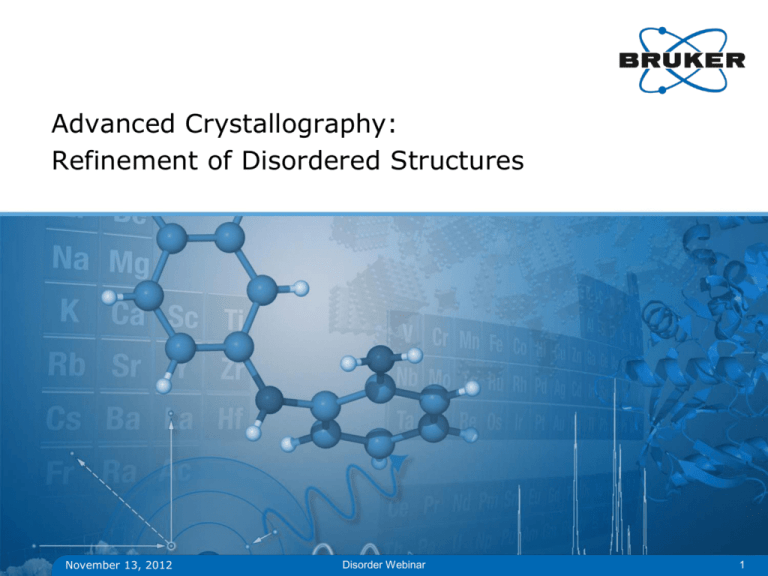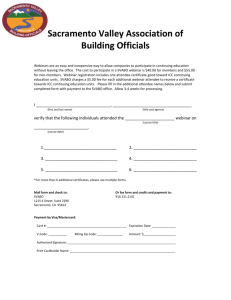
Advanced Crystallography:
Refinement of Disordered Structures
November 13, 2012
Disorder Webinar
1
This Webinar is being broadcast from our
Madison, Wisconsin, USA, facility
November 13, 2012
Disorder Webinar
2
Charles Campana, Ph.D.
Senior Applications Scientist at
Bruker AXS, Madison, WI, USA
• BS, Chemistry (1970), Montana
State University, Bozeman,
Montana
• PhD (1975), Inorganic Chemistry
(with L. F. Dahl), University of
Wisconsin, Madison, Wisconsin
• Assistant Professor (1976 –
1980), University of New Mexico
University, Albuquerque, New
Mexico
• Senior Applications Scientist
(1980 - present) Single-Crystal Xray Diffraction, Nicolet, Siemens
and Bruker;
• Crystallographic co-author on
several hundred scientific papers.
November 13, 2012
Disorder Webinar
3
Audience Poll
Please use your mouse to answer the
question on your screen:
What is your experience level?
I have not done any crystal
structures
I have done only routine structures
I have done problem structures
I’m a crystallographer
November 13, 2012
4
Introduction
Modern X-ray crystallographic systems with automatic features have made it
possible for synthetic chemists with limited crystallographic training to obtain
publication-quality crystal structures quickly and easily for routine structures.
While the automated structure routines perform well on straight-forward
molecular compounds, these routines are not capable of automatically
modeling various disorder problems.
In these cases, the user must utilize some of the advanced SHELXL/XL
instructions involving the use of free variables, constraints and restraints to
successfully refine and publish his / her results.
All of these techniques involve editing the SHELXL/XL output (*.res) file, with
either a text editor or a specialized graphical editor, to produce a new, modified
SHELXL/XL input (*.ins) file.
November 13, 2012
Disorder Webinar
5
George Sheldrick
Professor of Structural Chemistry and parttime programming technician at the
University of Göttingen
•
PhD (1966) University of Cambridge with
E.A.V. Ebsworth; thesis entitled "NMR
Studies of Inorganic Hydrides"
• 1966 - 1978: University Lecturer and
Fellow of Jesus College, Cambridge
• Since 1978 Professor at the University of
Göttingen
• Since 2011 Niedersachsen Professor at
the University of Göttingen (emeritus)
• Author of about 800 scientific papers and
of a computer program called SHELX
(http://shelx.uni-ac.gwdg.de/SHELX/)
Sheldrick, GM (2008) A short history of SHELX.
Acta Crystallogr., A64:112-122 (open access)
This paper is currently the most highly cited
scientific paper of the last five years in all
subjects.
November 13, 2012
Disorder Webinar
6
SHELX References
•
A short history of SHELX, Sheldrick, GM (2008)
(http://journals.iucr.org/a/issues/2008/01/00/sc5010/sc5010.pdf)
•
SHELX Manual (http://shelx.uni-ac.gwdg.de/SHELX/shelx.pdf)
•
Crystal Structure Refinement: A Crystallographer's Guide to
SHELXL (International Union of Crystallography Texts on
Crystallography)
November 13, 2012
Disorder Webinar
7
SHELXTL vs. SHELX*
http://shelx.uni-ac.gwdg.de/SHELX/index.html
SHELXTL (Bruker AXS)
•
•
•
•
•
•
•
•
•
•
XPREP
XS
XM
XE
XL
XPRO
XWAT
XP
XSHELL
XCIF
November 13, 2012
SHELX (Public Domain)*
• None
• SHELXS
• SHELXD
•
SHELXE
•
•
•
•
•
•
SHELXL
SHELXPRO
SHELXWAT
None
None
CIFTAB
Disorder Webinar
8
Peter Müller, MIT
Director of the Diffraction Facility
MIT Department of Chemistry
Cambridge, Massachusetts
November 13, 2012
Disorder Webinar
9
Objectives of this presentation
•
•
•
•
•
Use of text editors or graphical editors to insert additional
instructions into SHELXL / XL input instruction (*.ins) files.
Introduction to the concepts of constraints and restraints in crystal
structure refinement.
Introduction to the internal atom connectivity concept and PART n
and PART –n instructions.
Introduction to the use of free variables in constraints and
restraints.
Examples of commonly used instructions for applying a variety of
constraints and restraints to the refinement of disordered
structures.
November 13, 2012
10
Constraints and Restraints
•
In crystal structure refinement, there is an important distinction
between a 'constraint' and a 'restraint'.
•
A constraint enables one or more least-squares variables to be
expressed exactly in terms of other variables or constants, and
hence eliminated.
•
A restraint takes the form of additional information which is not
exact but is subject to a probability distribution; for example we
could restrain two chemically but not crystallographically equivalent
bonds to be approximately equal.
November 13, 2012
Disorder Webinar
11
Constraints and Restraints in SHELXL
The following general categories of constraints and restraints are
available using SHELXL:
•
Constraints for the coordinates and anisotropic displacement parameters for atoms on
special positions: these are generated automatically by the program for ALL special
positions in ALL space groups, in conventional settings or otherwise.
•
Floating origin restraints: these are generated automatically by the program, so the
user should not attempt to fix the origin in such cases by fixing the coordinates of a
heavy atom.
•
Two or more atoms sharing the same site: the xyz and Uij parameters may be equated
using the EXYZ and EADP constraints respectively (or by using 'free variables'). The
occupation factors may be expressed in terms of a 'free variable' so that their sum is
constrained to be constant (e.g. 1.0). If more than two different chemical species
share a site, a linear free variable restraint (SUMP) is required to restrain the sum of
occupation factors.
•
Geometrical constraints: these include rigid-group refinements (AFIX 6), variablemetric rigid-group refinements (AFIX 9) and various riding models (AFIX/HFIX) for
hydrogen atom refinement, for example torsional refinement of a methyl group about
the local threefold axis.
November 13, 2012
Disorder Webinar
12
Constraints and Restraints in SHELXL
•
Fragments of known geometry may be fitted to target atom, and the coordinates
generated for any missing atoms. Four standard groups are available: regular
pentagon, regular hexagon, naphthalene and pentamethylcyclopentadienyl.
Other groups may be used simply by specifying orthogonal or fractional
coordinates in a given cell (AFIX mn with m > 16 and FRAG...FEND).
•
Geometrical restraints: a particularly useful restraint is to make chemically but not
crystallographically equivalent distances equal without having to invent a value for this
distance (SADI). The SAME instruction can be used to generate such restraints
automatically, e.g. when chemically identical molecules or residues are present. This
has the same effect as making equivalent bond lengths and angles but not torsion
angles equal. The FLAT instruction restrains a group of atoms to lie in a plane (but the
plane is free to move and rotate).
•
Restraints on anisotropic displacement parameters: three different types of restraint
may be applied to Uij values. DELU applies a 'rigid-bond' restraint to Uij of two bonded
(or 1,3) atoms; the anisotropic displacement components of the two atoms along the
line joining them are restrained to be equal. Isolated atoms may be restrained to be
approximately isotropic (ISOR). Similarly, the assumption of 'similar' Uij values
for spatially adjacent atoms (SIMU) is useful for partially overlapping atoms of
disordered groups.
November 13, 2012
Disorder Webinar
13
Types of constraints in SHELXL
•
Constraints for special positions: the necessary constraints on
occupancies and Uij are derived automatically.
•
Rigid groups (AFIX 6 … AFIX 0): the 3 positional parameters per atom are replaced by
3 rotations and 3 translations for the whole rigid group. Atoms may not be in more than
one rigid group.
•
Riding hydrogen atoms (AFIX mn): xH = xC + x
extra positional parameters.
•
Fixed parameters: add 10 to x, y, z, occ, U etc. Typically occupancies are fixed at 1.0
by adding 10, i.e. given as 11.0
•
Free variables: can be used to add extra linear constraints to the usual refinement
parameters and also be used instead of restraint target values. This provides a
convenient way of getting target values with esd’s for use as restraints in other
structures.
November 13, 2012
Disorder Webinar
co-ordinates,
–
no
14
Special position constraints
Example: Atom on twofold axis in space group C2. The two positions related
by the twofold axis (x,y,z: -x,y,-z) coincide when x = 0 and z = 0. Since we
still wish to sum over all symmetry operators in the structure factor calculation,
the occupancy is fixed at 0.5. The probability ellipsoid used to describe the
anisotropic motion should not be changed by the 180º rotation.
[U11, U22, U33, U23, U13, U12] [U11, U22, U33, -U23, U13, -U12] which is only true
if U23 = 0 and U12 = 0. All these constraints are generated automatically by
SHELXL for all special positions in all space groups.
November 13, 2012
Disorder Webinar
15
Rigid group constraints
In SHELXL, rigid groups are defined by three rotations about the first atom in
the group and by three translations of the group as a whole. Special position
constraints may be applied to the first atom and restraints and riding hydrogen
atoms are allowed on all atoms in the group. Note that the esd’s of bond
lengths and angles but not of co-ordinates within a rigid group come out as
zero from the L.S. matrix algebra.
AFIX 6
…
atoms
…
AFIX 0
rigid group – all
bond lengths and
angles fixed
November 13, 2012
AFIX 9
…
atoms
…
AFIX 0
Disorder Webinar
variable metric
rigid group - angles
fixed, bond lengths
multiplied by the
same factor
16
The connectivity list
The connectivity list is used for the automatic generation of hydrogen atoms
and some restraints. Non-hydrogen atoms i and j are considered to be
‘bonded’ if:
dij < ri + rj + 0.5 Å
The CONN instruction may be used to modify r and to set a maximum
connectivity for an atom (e.g. 0 for water). A shell of symmetry equivalents is
generated automatically around the unique atoms. Bonds may be added with
BIND or deleted with FREE.
PART N controls the generation of bonds for disordered groups. Most atoms
have N = 0; multiple conformations have N = 1, 2 etc. Bonds are generated
only when the N are equal or one N is zero. If N is negative, bonds are not
made to symmetry equivalents.
November 13, 2012
Disorder Webinar
17
Free variables
Free variables are an extremely concise but effective way of applying linear
constraints to atom parameters (especially occupancies), restraint targets etc.
The parameter x is given as (10m+p), which is interpreted as follows:
m = 0: refine normally, starting at value p
m = 1: fix at value p
m > 1: x = p* fv(m)
m <-1: x = p* [fv(–m) – 1]
e.g., 30.25 (m = 3, p = 0.25) means 0.25*[fv(3)] and –30.25 (m = –3, p = –
0.25) means 0.25*[1 – fv(3)], which could be used to constrain two
occupancies to add up to 0.25 (only one parameter, free variable #3, is
refined). The starting values for the free variables are given on the FVAR
instruction (but free variable #1 is the overall scale factor).
November 13, 2012
Disorder Webinar
18
Standard SHELX Instructions
TITL
CELL
ZERR
LATT
SYMM
SYMM
SYMM
SFAC
UNIT
TEMP
SIZE
YLID in P2(1)2(1)2(1)
0.71073
5.9651
9.0437
4.00
0.0002
0.0003
-1
0.5-X, -Y, 0.5+Z
-X, 0.5+Y, 0.5-Z
0.5+X, 0.5-Y, -Z
C H O S
44 40 8 4
23.000
0.32 0.34 0.34
18.4047
0.0006
90.000
0.000
90.000
0.000
90.000
0.000
L.S. 4
BOND
FMAP 2
PLAN 20
FVAR
S1
C1
C2
O1
C3
C4
C5
C6
C7
C8
O2
C9
C10
C11
4
1
1
3
1
1
1
1
1
1
3
1
1
1
1.00000
0.19050
0.36850
0.31150
0.16360
0.49610
0.52540
0.70740
0.84660
0.82480
0.65310
0.66890
0.56180
0.16570
0.34520
0.68120
0.62830
0.50160
0.40830
0.49860
0.41640
0.44010
0.54890
0.64010
0.61620
0.80130
0.69740
0.88170
0.68260
0.74160
0.67080
0.62620
0.63170
0.56590
0.51090
0.46220
0.47510
0.53680
0.58110
0.67590
0.64820
0.72670
0.82310
11.00000
11.00000
11.00000
11.00000
11.00000
11.00000
11.00000
11.00000
11.00000
11.00000
11.00000
11.00000
11.00000
11.00000
0.05000
0.05000
0.05000
0.05000
0.05000
0.05000
0.05000
0.05000
0.05000
0.05000
0.05000
0.05000
0.05000
0.05000
HKLF 4
November 13, 2012
Disorder Webinar
19
Graphical Editors for SHELXL/XL files
•
XP (Bruker AXS Inc.)
•
XShell (Bruker AXS Inc.)
•
APEX2 (Bruker AXS Inc.)
•
WinGX (L. Farrugia)
•
Crystals (D. Watkin et al.)
•
X-Seed (L. Barbour)
•
shelXle (C. Hubschle et al.)
•
OLEX2 (O. Dolomanov et al.)
November 13, 2012
Disorder Webinar
20
Two cations sharing the same site
The best strategy is to constrain the positions and displacement parameters to be
the same, and refine the occupancies so that their sum is constrained to be unity:
EXYZ MG CA
EADP MG CA
FVAR 1.0 0.6
..
PART 1
MG 6 0.37041 0.34874 0.03824 21.0
PART 2
CA 7 0.37041 0.34874 0.03824 -21.0
PART 0
0.20936
0.20936
If the cations were sharing a special position on a twofold axis, their occupancies
would be specified as 20.5 and –20.5. For three atoms (or molecules) sharing a
site, it is better to tether each occupancy to a free variable (e.g. by 31, 41 and 51)
and to restrain the sum of these free variables to unity:
SUMP 1.0 0.001 1.0 1 1.0 2 1.0 3
November 13, 2012
Disorder Webinar
21
DFIX or SADI?
The DFIX restraint is able to restrain bond lengths to target values but sometimes the
target is uncertain. For example the P―O distance in a phosphate may vary with the pH
and the extent of libration. SADI can be very useful in such cases, e.g.
SADI
SADI
P O1
O1 O2
P O2
O1 O3
P O3
O1 O4
P O4
O2 O3
O2 O4
O3 O4
ensures that the phosphate will be a regular tetrahedron, but allow the bond length to
refine.
The same can however be achieved by an AFIX 9 constraint or by using DFIX with a free
variable, e.g.
FVAR
……
……
1.55
DFIX 31 P O1 P O2
DFIX 31.6330 O1 O2
November 13, 2012
P O3 P O4
O1 O3 O1 O4
O2 O3
Disorder Webinar
O2 O4
O3 O4
22
The rigid-bond restraint DELU
•
In SHELXL, the DELU restraint is a strict rigid-bond restraint, i.e. the
components of the anisotropic motion of two atoms along the line joining
them are restrained to be equal.
•
Although DELU is a reliable restraint and so can be given a small esd, there
are not as many DELU restraints as Uij, so it may be necessary to
supplement them with the less accurate but more numerous SIMU and
ISOR restraints with larger esd’s.
November 13, 2012
Disorder Webinar
23
Restraints on ADP's
November 13, 2012
Disorder Webinar
24
Toluene on an inversion center
•
Toluene is a good solvent for growing crystals because of its long liquid range, but it
simply cannot resist inversion centers:
•
This can be handled with one complete toluene molecule with occupancies of 10.5
(fixed at 0.5) and PART -1. Equivalent 1,2- and 1,3-distances can be restrained to be
equal with SADI and a FLAT restraint applied to all 7 carbons, or a rigid hexagon can
be used for the 6-membered ring (plus two SADI and one CHIV for the CH3). SIMU
and DELU are recommended. The hydrogen atoms should be set with HFIX in a later
job:
•
•
HFIX 43 C1 > C5
HFIX 123 C7
November 13, 2012
(generates 5H with occupancies of 0.5)
(generates 6H with occupancies of 0.25)
Disorder Webinar
25
Use of PART 1, PART 2 and SAME
ISOR
DELU
WGHT
FVAR
PART
C1A
1
.
.
C17A
1
AFIX
H17A
AFIX
PART
SAME
C1B
.
.
C17D
AFIX
H17D
AFIX
PART
0.045500
0.22187
1
0.42827
0.23894
0.85590 10.50000
0.04915
0.00377
0.01463 -0.00748
0.04467
0.03563 =
0.42023
0.25662
1.14925 10.50000
0.05014 -0.00305 -0.00756
0.00391
43
2
0.53968
0.31799
1.15025 10.50000
0
2
C1A > C17A
1
0.47550
0.26048
1.14359 10.50000
0.04839
0.00438 -0.00897
0.00686
0.05042
0.04274 =
0.04169
0.03667 =
1
0.03704
0.02547 =
0.23382 -0.11832
0.35155 10.50000
0.04522
0.00395
0.00013 -0.00093
43
2
0.16654 -0.00313
0.35229 10.50000
0
0
November 13, 2012
0.05761
0.02412
Disorder Webinar
26
Use of PART 1, PART 2 and SAME
Part 1
November 13, 2012
Part 2
Disorder Webinar
Parts 1 & 2
27
Ethyl acetate disordered about a 2-fold
axis
FVAR
C1
1
.
.
O6
3
0.07920
0.57624
1.056270
0.672587
0.015161
11.00000
0.19702
-0.03184
0.00034
0.03626
0.793446
0.479760
0.011891
11.00000
0.06854
-0.00308
-0.00415
0.05024
SAME C1 > O6
PART -1
C1'
1
0.122354
-0.092142
0.016919
20.50000
0.20344
0.02675
-0.02623
0.07727
.
.
AFIX
0
O6'
3
0.167969
0.159420
0.007654
20.50000
0.12535
0.00968
-0.00772
0.03937
PART
0
November 13, 2012
0.07754
0.17320 =
0.07630
0.08652 =
0.16721
0.13875 =
0.08280
0.06135 =
Disorder Webinar
28
Disordered t-butyl group
November 13, 2012
29
Disorder between Cl and C
November 13, 2012
30
Disorder of a cyclopentadienyl ring
November 13, 2012
31
November 13, 2012
Disorder Webinar
32
Disorder of a chloroform molecule on a
mirror plane
November 13, 2012
Disorder Webinar
33
DMSO disordered over three positions
November 13, 2012
Disorder Webinar
34
Example 1 - Os3(CO)10(PPh2~PPh2)
•
Background
• Sample from UCSD Summer School
• Prof. Michael Richmond et al. (U. of North Texas)
• NMR indicated dynamic equilibrium between two isomers
•
Structure was easily ‘solved’, but could not be refined
• R1 = 16%
• Many NPD atoms
• Three very large difference peaks (‘Star of David’)
November 13, 2012
35
Example 1 - Os3(CO)10(PPh2~PPh2)
preliminary structure – chelating phosphine ligand
November 13, 2012
36
Example 1 - Os3(CO)10(PPh2~PPh2)
L.S.
BOND
FMAP
PLAN
WGHT
FVAR
ANIS
OS1
OS2
OS3
C1A
O1A
C2A
O2A
C3A
O3A
C4A
O4A
C5A
O5A
C6A
O6A
C7A
O7A
C8A
O8A
C9A
O9A
C10A
O10A
ANIS
P1
P2
C1
C2
C3
•
November 13, 2012
4
2
99
0.040000
0.15477
0.8500
3
5
5
5
1
3
1
3
1
3
1
3
1
3
1
3
1
3
1
3
1
3
1
3
2
4
4
1
1
1
1.38180
1.16037
1.22802
1.22737
1.14724
1.53166
1.61483
1.00907
0.91212
1.33420
1.42200
1.13429
1.11507
1.03019
0.94876
1.12667
1.06313
1.33629
1.39946
1.34144
1.39311
1.07098
0.98114
0.36327
0.44356
0.46498
0.29544
0.25371
0.43473
0.47245
0.38885
0.35992
0.49045
0.51620
0.40796
0.38537
0.51972
0.56097
0.38230
0.34129
0.53964
0.58535
0.46478
0.47459
0.52231
0.55458
0.23664
0.29321
0.16310
0.22637
0.21696
0.24515
0.24881
0.25481
0.23556
0.32785
0.35349
0.37402
0.42076
0.29063
0.28462
0.13189
0.11120
0.20167
0.21995
0.08771
0.04379
0.13931
0.12305
21.00000
21.00000
21.00000
21.00000
21.00000
21.00000
21.00000
21.00000
21.00000
21.00000
21.00000
21.00000
21.00000
21.00000
21.00000
21.00000
21.00000
21.00000
21.00000
21.00000
21.00000
21.00000
21.00000
0.01306
0.01737
0.01676
0.01424
0.01327
0.02705
0.01637
0.02644
0.03082
0.02520
0.02519
0.01968
0.04168
0.02206
0.04682
0.02768
0.02261
0.02088
0.02206
0.02607
0.02768
0.02470
0.04529
1.49269
1.51235
1.64848
1.64668
1.77319
0.30401
0.30162
0.25992
0.26068
0.22528
0.31810
0.16667
0.21803
0.28099
0.30686
11.00000
11.00000
11.00000
11.00000
11.00000
0.01685
0.02253
0.02086
0.02963
0.03008
37
Example 1 - Os3(CO)10(PPh2~PPh2)
three large difference peaks
November 13, 2012
38
Example 1 - Os3(CO)10(PPh2~PPh2)
L.S. 4
BOND
FMAP 2
PLAN 99
WGHT
0.040000
FVAR
0.14765
PART 1
ANIS
3
OS1
5
1.381809
OS2
5
1.160375
OS3
5
1.228021
PART 2
ANIS
3
OS4
5
1.279201
OS5
5
1.356916
OS6
5
1.132255
PART 1
C1A
1
1.227149
O1A
3
1.147208
C2A
1
1.531363
O2A
3
1.614757
...
C9A
O9A
C10A
O10A
PART
ANIS
P1
P2
C1
C2
November 13, 2012
1
3
1
3
0
2
4
4
1
1
0.84986
0.363269
0.443563
0.464972
0.236644
0.293216
0.163111
21.00000
21.00000
21.00000
0.01398
0.01832
0.01769
0.372329
0.404339
0.478575
0.290337
0.165486
0.221611
-21.00000
-21.00000
-21.00000
0.01897
0.01516
0.02121
0.295498
0.253766
0.434503
0.472385
0.226379
0.216857
0.245167
0.248824
21.00000
21.00000
21.00000
21.00000
0.01463
0.01437
0.02786
0.01766
1.341290
1.392650
1.071073
0.981357
0.464934
0.474727
0.522226
0.554645
0.087821
0.043766
0.139298
0.123065
21.00000
21.00000
21.00000
21.00000
0.02657
0.02908
0.02516
0.04658
1.492683
1.512382
1.648401
1.646876
0.304015
0.301606
0.259913
0.260442
0.318087
0.166718
0.218106
0.280954
11.00000
11.00000
11.00000
11.00000
0.01777
0.02357
0.02206
0.03039
39
Example 1 - Os3(CO)10(PPh2~PPh2)
remaining carbonyl atoms revealed in difference map
November 13, 2012
40
Example 1 - Os3(CO)10(PPh2~PPh2)
superposition of both isomers
November 13, 2012
41
Example 1 - Os3(CO)10(PPh2RPPh2)
chelating phosphine ligand
(85%)
November 13, 2012
bridging phosphine ligand
(15%)
Disorder Webinar
42
Example 1 - Os3(CO)10(PPh2~PPh2)
Crystallographic restraints (SADI, ISOR, SIMU, EADP) were used in initial refinement
Final refinement converged at R1 = 5.2%
Kandala, S.; Yang, L.; Campana, C. F.; Nesterov, V.; Wang, X.; Richmond, M. G. (2010) Isomerization
of the diphosphine ligand 3,4-bis(diphenylphosphino)-5-methoxy-2(5H)-furanone (bmf) at a triosmium
cluster and P-C bond cleavage in the unsaturated cluster 1,1-Os3(CO)9(bmf): Synthesis and x-ray
diffraction structures of the isomeric Os3(CO)10(bmf) clusters and HOs3(CO)8(μ-C6H4)[μPhPC:C(Ph2P)CH(OMe)OC(O)]. Polyhedron, 29, 2814-2821.
November 13, 2012
Disorder Webinar
43
Example 2 – Urea Host : Guest Complex
• Background
• Prof. Mark Hollingsworth et al. (Kansas State U.)
• Urea host lattice with long-chain carboxylic acid in
channels
• Structure of urea lattice was ‘solved’, but carboxylic acid
molecules could not be located
• Apparent unit cell
• Orthorhombic P212121
• a = 8.3096 Å , b = 10.9591 Å , c = 13.6330 Å
• 12 Urea molecules, 4 carboxylic acid molecules per cell
November 13, 2012
44
Example 2 – Urea Host : Guest Complex
projection down b-axis
November 13, 2012
45
Example 2 – Urea Host : Guest Complex
Projection down a-axis
November 13, 2012
46
Example 2 – Urea Host : Guest Complex
analysis of Q-peaks
November 13, 2012
47
Example 2 – Urea Host : Guest Complex
analysis of Q-peaks
November 13, 2012
48
Example 2 – Urea Host : Guest Complex
N2C
AFIX
H2CA
H2CB
AFIX
PART
C1S
O1S
O2S
AFIX
H2S
AFIX
C2S
AFIX
H2SA
H2SB
AFIX
3
93
2
2
0
-1
1
4
4
3
2
0
1
23
2
2
0
0.662814
0.937759
0.024542
11.00000
0.02028
0.626060
0.753628
1.006875
0.936746
0.048581
-0.008654
11.00000
11.00000
0.05118
0.05692
0.047758
-0.065938
0.147213
0.093743
0.059457
0.019479
0.256429
0.208123
0.303494
10.33333
10.33333
10.33333
0.02221
0.03123
0.03285
0.117603
-0.055411
0.292184
10.33333
0.05883
0.090446
0.226023
0.271096
10.33333
0.02369
0.196427
0.103898
0.240424
0.240028
0.240008
0.342366
10.33333
10.33333
0.03582
0.05245
0.080032
1.122110
0.284898
10.33333
0.02266
0.095393
0.185537
1.108073
1.108980
0.356020
0.252859
10.33333
10.33333
0.03019
0.07844
0.034726
-0.087391
0.147522
1.252421
1.287204
1.327757
0.270929
0.233376
0.305089
10.33333
10.33333
10.33333
0.02477
0.03143
0.03101
0.123082
1.402847
0.301909
10.33333
0.66676
....
C10S
AFIX
H10A
H10B
AFIX
C11S
O3S
O4S
AFIX
H4S
PART
November 13, 2012
1
23
2
2
0
1
4
4
3
2
0
49
Example 2 – Urea Host : Guest Complex
• Anisotropic refinement of dicarboxylic acid
• Final refinement
• R1 = 3.83%
• Temperature factors on hydrogen atoms refined
November 13, 2012
50
Example 3 - Fe3(CO)12 Crystallographic
Problem
•
Space group is P21/n with Z = 2
•
Each molecule must lie on a crystallographic center of symmetry
•
Successful refinement is difficult because it requires two halfweighted molecules superimposed on the center of symmetry
Example 3 - Fe3(CO)12 Refinement Results
100K Data
•
•
•
•
Resolution – 0.40Å
R1 = 3.82%
wR2 = 9.14%
12633 Ind. Refl.
298K Data
•
•
•
•
Resolution – 0.65Å
R1 = 5.11%
wR2 = 13.45%
2989 Ind. Refl.
Example 3 - Fe3(CO)12
PART
FE1
-1
3
FE2
3
FE3
3
C1
1
O1
2
C2
1
O2
2
C3
1
O3
2
.
.
.
.
C11
1
O11
2
C12
1
O12
2
PART
-0.055374
-0.020549
-0.170035
10.50000
0.01192
-0.00304
0.00029
0.00180
0.178487
-0.013488
0.072272
10.50000
0.01623
-0.00211
0.00057
0.00456
-0.113197
0.044515
0.114740
10.50000
0.01485
-0.00692
0.00156
0.00141
0.081260
0.147371
0.115557
10.50000
0.01724
-0.00283
0.00109
-0.00231
0.126014
0.245819
0.134149
10.50000
0.02873
-0.00442
0.00366
-0.00946
0.021315
-0.103724
0.184318
10.50000
0.01435
-0.00137
0.00099
0.00160
0.008896
-0.191357
0.252741
10.50000
0.02342
0.00376
0.00923
0.00349
-0.081841
-0.177419
-0.115438
10.50000
0.01636
-0.00508
0.00216
-0.00150
-0.103377
-0.276377
-0.093423
10.50000
0.03320
-0.00557
0.00597
-0.00602
0.01726
0.01813 =
0.01366
0.03072 =
0.01190
0.02706 =
0.01956
0.02010 =
0.04116
0.01783 =
0.02054
0.01953 =
0.04893
0.02094 =
0.01853
0.01948 =
0.03593
0.02098 =
-0.287792
-0.062646
0.088306
10.50000
0.02577
-0.00620
0.00431
-0.00036
-0.394246
-0.123109
0.074063
10.50000
0.05354
-0.01977
0.00761
-0.00933
-0.225303
0.177277
0.034806
10.50000
0.02324
-0.00162
0.00748
-0.00024
-0.293440
0.264375
0.000260
10.50000
0.03472
-0.00706
0.01154
-0.00290
0.02252
0.03041 =
0.02464
0.04749 =
0.01673
0.03692 =
0.02529
0.04527 =
0
November 13, 2012
Disorder Webinar
53
Example 3 - Fe3(CO)12 - shelXle diagrams
November 13, 2012
Disorder Webinar
54
50% Thermal Ellipsoids
100K
298K
Example 3 - Fe3(CO)12 Bond Lengths
100K
298K
•
•
•
Fe(1) -Fe(2) 2.6932(3) Å
Fe(2)- Fe(3) 2.6993(3) Å
Fe(2)-Fe(3) 2.5591(4) Å
•
•
•
Fe(1) -Fe(2) 2.6766 (11) Å
Fe(2)- Fe(3) 2.6806 (11) Å
Fe(2)-Fe(3) 2.5547 (12) Å
•
•
•
•
Fe(2)-C(1)
Fe(2)-C(2)
Fe(3)-C(1)
Fe(3)-C(2)
•
•
•
•
Fe(2)-C(1)
Fe(2)-C(2)
Fe(3)-C(1)
Fe(3)-C(2)
2.013(4)
1.985(4)
1.989(4)
2.020(4)
Å
Å
Å
Å
2.095(8)
2.042(8)
2.063(8)
2.129(8)
Å
Å
Å
Å
Example 3 - Fe3(CO)12 Bond Lengths
100K
298K
•
•
•
Fe(1) -Fe(2) 2.6932(3) Å
Fe(2)- Fe(3) 2.6993(3) Å
Fe(2)-Fe(3) 2.5591(4) Å
•
•
•
Fe(1) -Fe(2) 2.6766 (11) Å
Fe(2)- Fe(3) 2.6806 (11) Å
Fe(2)-Fe(3) 2.5547 (12) Å
•
•
•
•
•
•
Fe(2)-C(1)
Fe(2)-C(2)
Fe(3)-C(1)
Fe(3)-C(2)
C(1)-O1)
C(2)-O(2)
•
•
•
•
•
•
Fe(2)-C(1)
Fe(2)-C(2)
Fe(3)-C(1)
Fe(3)-C(2)
C(1)-O1)
C(2)-O(2)
2.013(4) Å
1.985(4) Å
1.989(4) Å
2.020(4) Å
1.161(3) Å
1.163(3) Å
2.095(8) Å
2.042(8) Å
2.063(8) Å
2.129(8) Å
1.088(6) Å
1.112(6) Å
Example 3 - Fe3(CO)12
Comparison of 100K and 298K Structures
Example 3 - Fe3(CO)12 Conclusions
Collection of low temperature (100K) data to high resolution
(0.40 Å) facilitates the separation of overlapped peaks in
the disordered structure.
The refinement of the structure using the PART -1 instruction
in SHELX(TL) allows a stable refinement of the Fe3(CO)12
structure with no restraints.
The final structure a 100K exhibits only minor deviations from
idealized C2v molecular symmetry with symmetrically
bridging carbonyl ligands.
Although the results of the lower resolution (0.65 Å) dataset
collected at room temperature are not as precise, both
structures are nearly superimposable with the 100K
structure.
Review and Conclusions
•
•
•
•
•
Use of text editors or graphical editors to insert additional
instructions into SHELXL / XL input instruction (*.ins) files.
Introduction to the concepts of constraints and restraints in crystal
structure refinement.
Introduction to the internal atom connectivity concept and PART n
and PART –n instructions.
Introduction to the use of free variables in constraints and
restraints.
Examples on commonly used instructions for applying a variety of
constraints and restraints to the refinement of disordered
structures.
November 13, 2012
60
Questions and Answers
Any questions?
Please type any questions
you may have for our speakers
in the Q&A panel and
click Send.
How did we do?
When you exit the webinar, please fill
out our evaluation survey to let us
know. We appreciate your feedback.
Thank you!
November 13, 2012
Disorder Webinar
61
Available at
www.bruker.com/service/educationtraining/webinars/sc-xrd.html
November 13, 2012
62
Innovation with Integrity
© Copyright Bruker Corporation. All rights reserved.






